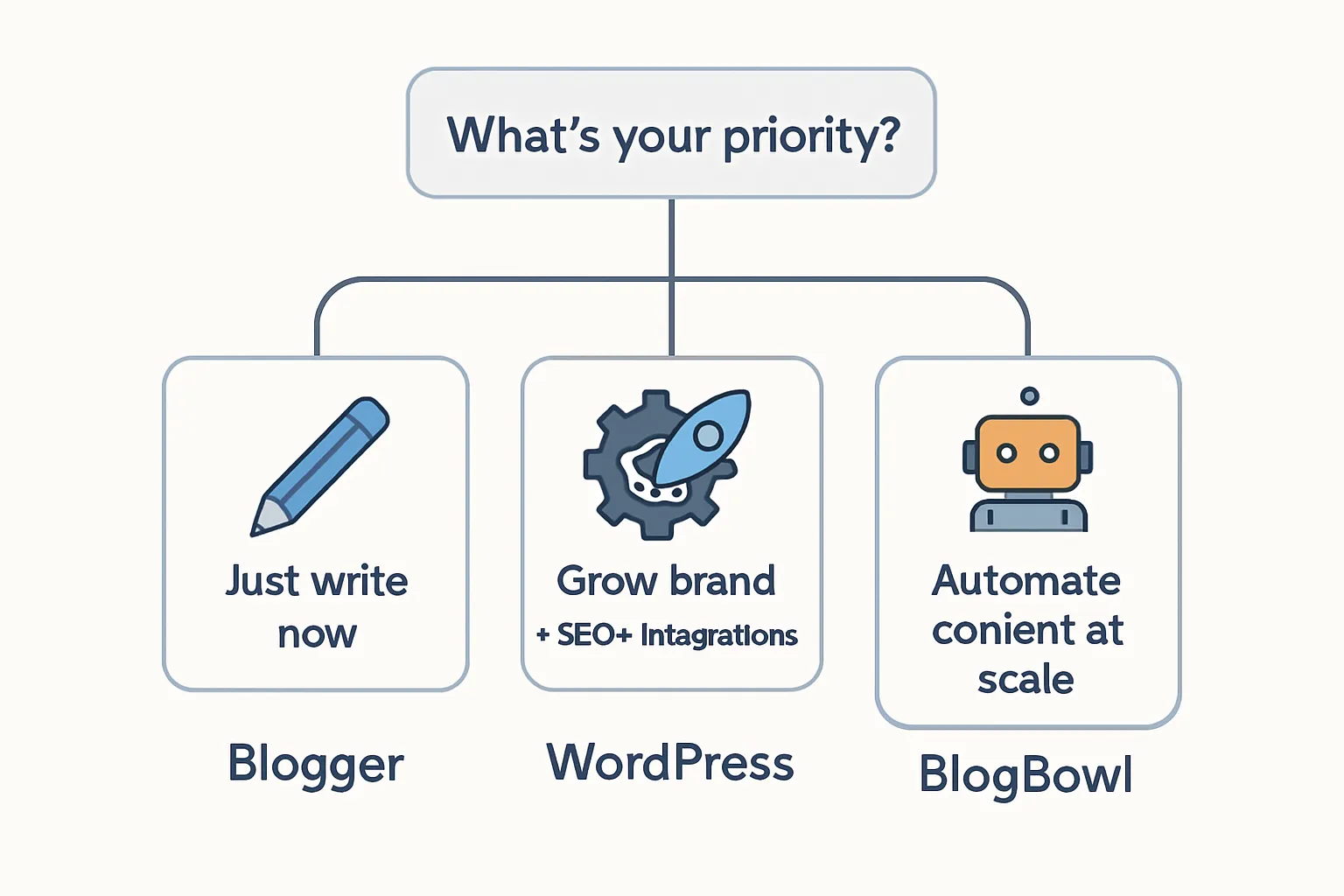Introduction: Blogger vs WordPress (2025) at a Glance
Blogging has grown up. What began as online journals is now a primary growth engine for brands, startups, and creators - powering SEO, thought leadership, demand generation, and product education. If you’re choosing a blogging platform in 2025, two names still dominate searches: Blogger vs WordPress. This guide is a practical, persona-focused comparison to help you pick what fits your goals today - and scales tomorrow.
We compare Blogger and WordPress.org specifically (the self-hosted, open-source WordPress). Quick note: WordPress.com is a hosted service with fewer customization and monetization options than WordPress.org; it’s closer to Blogger in simplicity but more limited for growth.
Who this guide is for:
Beginners who want a simple, low-friction start
Founders and marketers at startups & SaaS companies who need performance, SEO, and integrations
Solo creators who want to grow audiences and monetize content
30‑second takeaway:
Pick Blogger if you want a free, ultra-simple, maintenance-free blog to publish fast with built-in AdSense. Best for personal/hobby blogs or early testing.
Pick WordPress.org if you want full ownership, deep customization, powerful SEO tools, and monetization flexibility that can scale with your business.
Prefer zero maintenance and automation? Meet BlogBowl - an automation-first alternative for teams that want a professional, fast, SEO-optimized blog in under a minute. BlogBowl handles hosting, templates, analytics, newsletters, AI-written articles, internal linking, keyword research, and embedded media - so you focus on strategy, not setup.
"WordPress is used by 43.3% of all websites (October 2025)." - Source
Comparison at a glance
Feature | Blogger | WordPress.org |
|---|---|---|
Ownership | Hosted by Google; limited control | You own your data/site; full control |
Ease of setup | Minutes; no hosting needed | 30–60 min with hosting/domain |
Editor | Simple WYSIWYG | Block editor (Gutenberg) + page builders |
Customization depth | Basic templates; limited tweaks | Thousands of themes/plugins; full code access |
Integrations | Mostly Google ecosystem | Vast plugin ecosystem; APIs for most tools |
SEO controls | Basics (titles, permalinks) | Advanced SEO via plugins, schema, sitemaps |
Monetization | Built-in AdSense | Ads, affiliates, memberships, ecommerce |
Security/maintenance | Managed by Google | You manage updates, backups, hardening (plugins help) |
Pricing | Free (optional domain) | Hosting + domain; plugins/themes vary |
Scalability | Limited for complex needs | Scales from blog to enterprise site |
Support/community | Docs + forums | Massive community, docs, provider support |
Migration | Export basics only | Many importers; robust migration paths |
[youtube_video]
What makes this guide better than other comparisons:
Persona-based recommendations: clear picks for beginners, SaaS teams, and creators
TCO-aware guidance: we consider total cost of ownership (setup time, plugins, maintenance, and opportunity cost)
Clear migration paths: Blogger → WordPress.org and vice versa, plus when to switch
Near-term roadmap considerations: AI/automation readiness, including how platforms handle AI-generated content, internal linking, analytics, and publishing workflows (and where an automation-first platform like BlogBowl can remove complexity)
Who Are They For? Ownership, Control, and Longevity
Blogger in brief
Free, hosted by Google; fastest path to a simple personal or hobby blog
Low setup effort; limited extensibility; AdSense-first monetization
WordPress.org in brief
Open-source CMS that can run blogs, docs, marketing sites, and stores
You choose hosting, keep full content ownership, and can extend endlessly with themes/plugins
WordPress.com (quick note)
Hosted service with stricter limits; not the same as self-hosted WordPress.org
Ownership & portability
Data export/import, custom domains, control of backups and redirects
Platform risk: what happens if policies change or products sunset
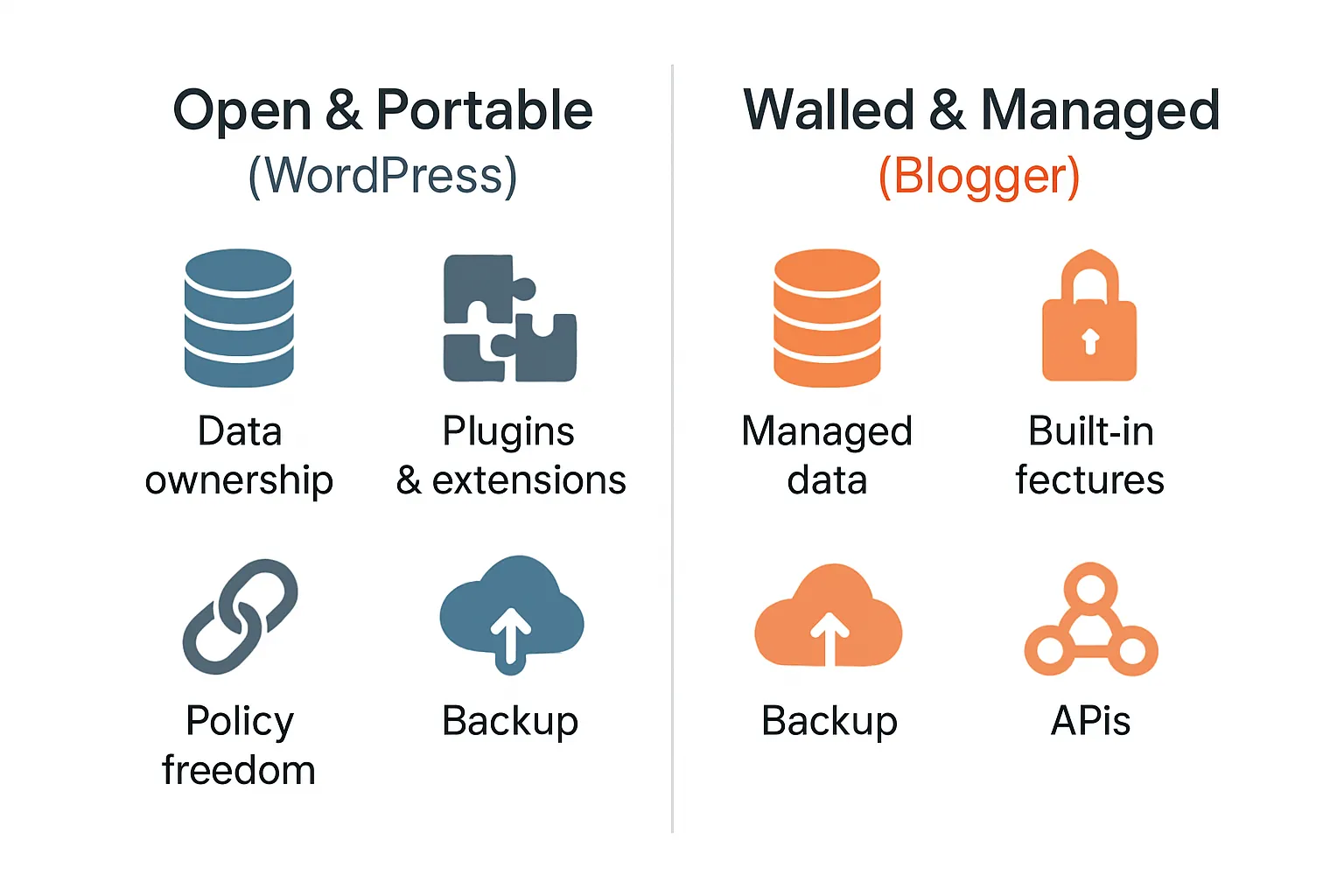
Decision cues
Choose Blogger when guaranteed simplicity beats control, and you want a free, maintenance-free start
Choose WordPress when long-term flexibility, brand building, SEO depth, and integrations matter
Consider BlogBowl when you want no-code speed plus ongoing AI automation (daily articles, internal linking, analytics, and newsletters baked in)
Getting Started & Writing Experience
Setup time and first publish
Blogger: sign in with Google, pick a template, publish
WordPress: domain + hosting, 1‑click install (many hosts), onboarding wizards
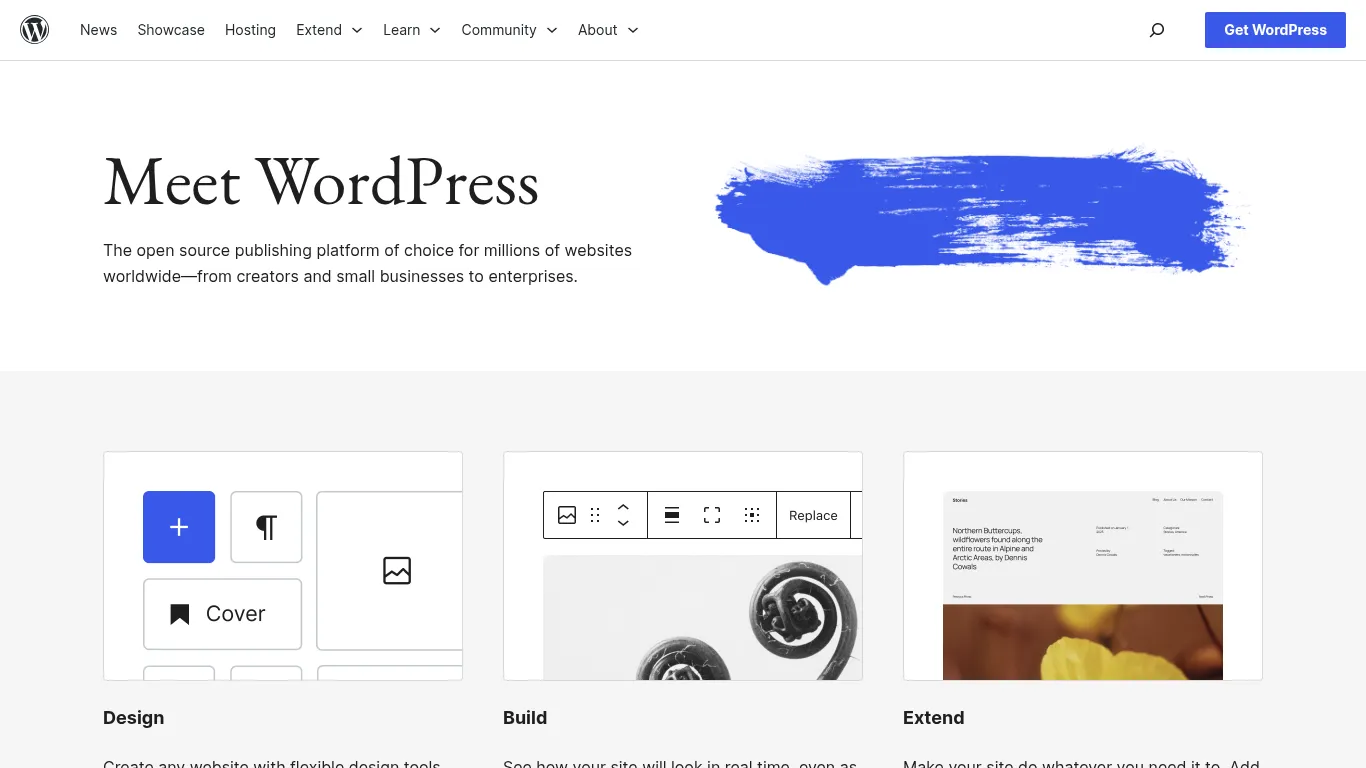
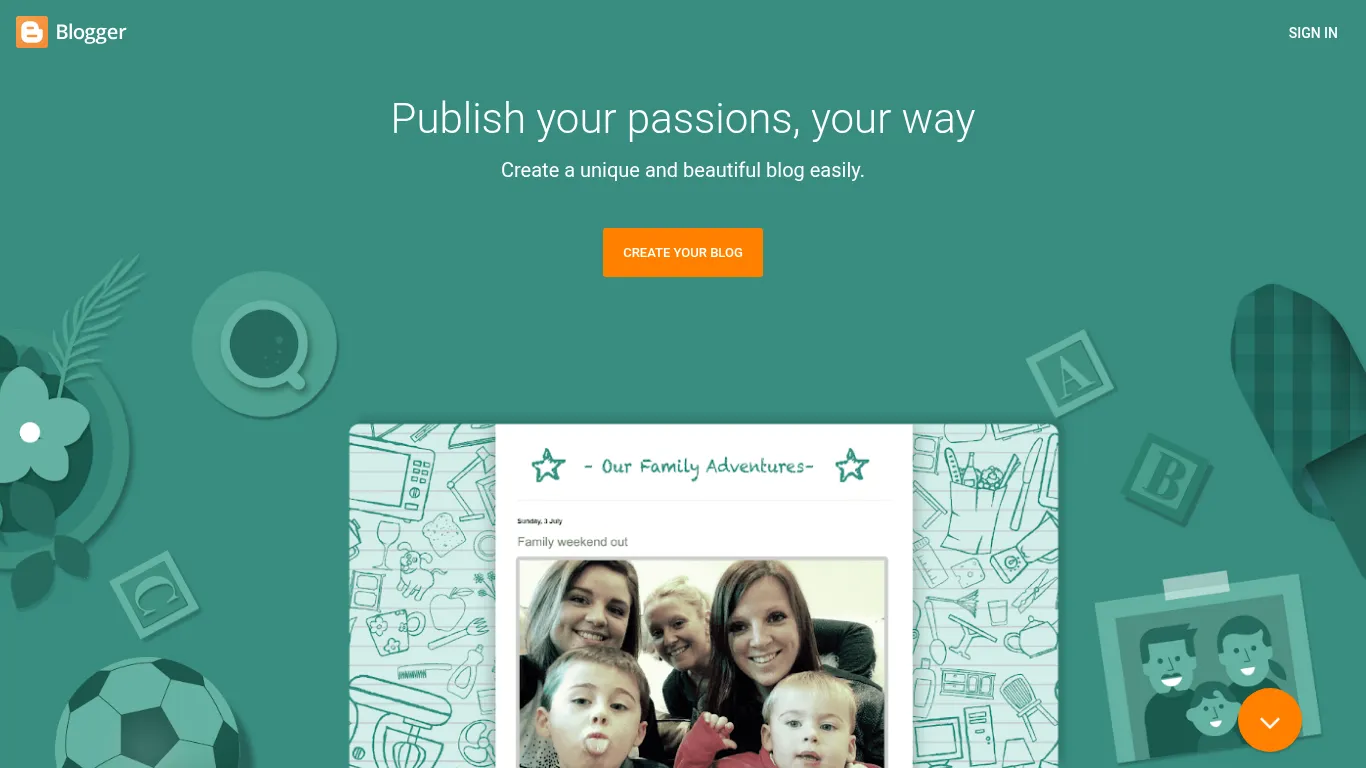
Editor UX
Blogger: classic WYSIWYG; simple formatting; labels; basic permalink control
WordPress: modern block editor (Gutenberg); reusable blocks, patterns, embeds; full-site editing capable themes
Workflow & collaboration
Both: drafts, scheduled posts, revisions
WordPress: multi-author roles (Administrator, Editor, Author, Contributor, Subscriber) and rich editorial workflows via plugins (calendars, approvals, style guides)
Mobile & media
Blogger: straightforward image uploads and YouTube embeds; basic media library
WordPress: robust media library with metadata, cropping, alt-text prompts; block-based embeds (YouTube, social, audio, galleries) and responsive images by default
Design & Customization: From Templates to Full Site Editing
Blogger
~a dozen official themes; minor variations; basic layout gadgets
Limited visual controls; custom CSS and template HTML for deeper changes
WordPress
Thousands of free and premium themes; block themes and full-site editing
Page builders (optional) and powerful pattern libraries; global styles
Safe ways to add custom CSS; child themes; developer hooks
Practical outcomes
Speed to a clean look vs the ability to craft brand-differentiated design
Accessibility and performance considerations when picking themes
"As of October 2025, the official WordPress Theme Directory offers over 13,000 free themes." - Source
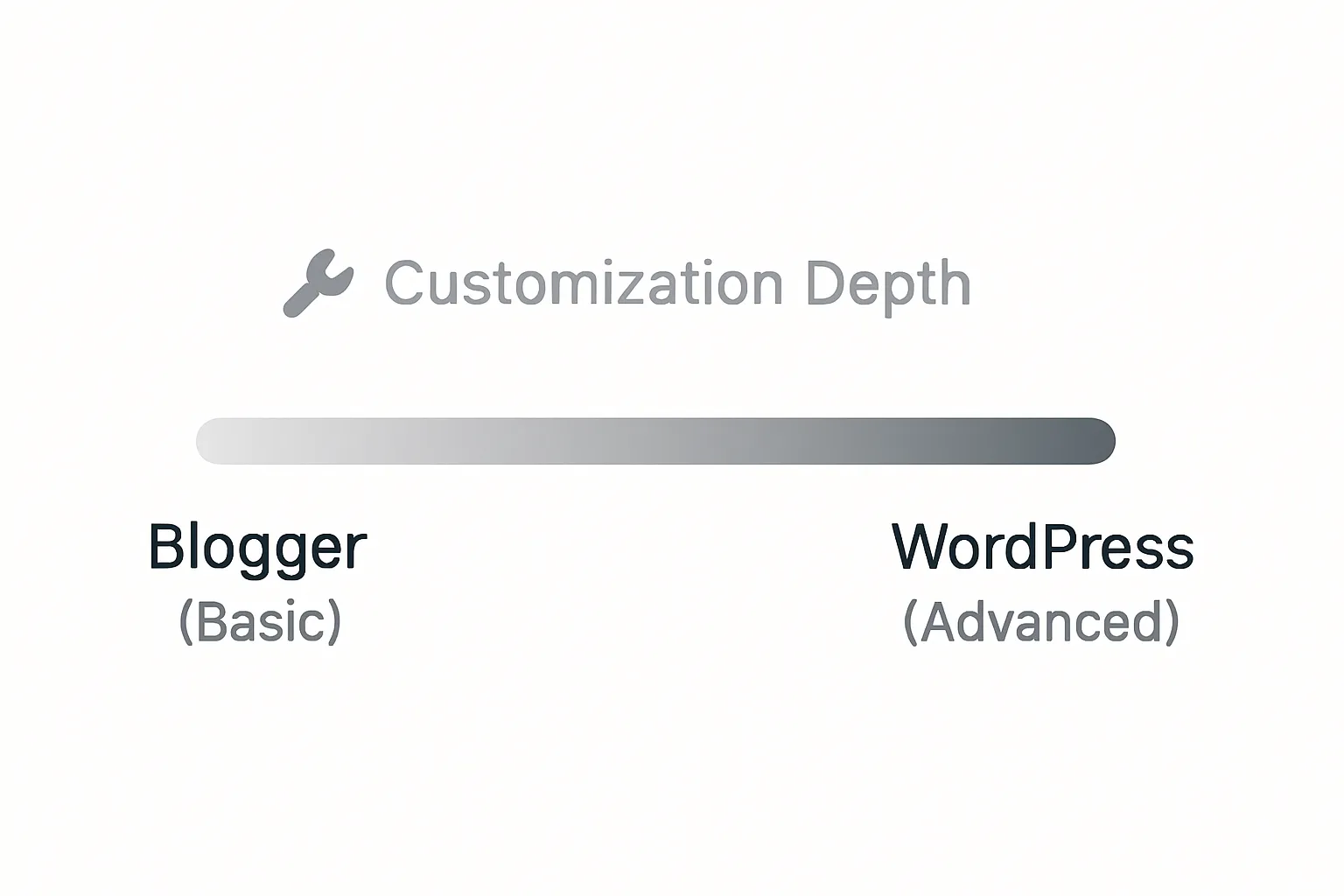
Integrations & Ecosystem
Blogger
Strong alignment with Google tools (Analytics, AdSense, Search Console)
Limited third-party integrations; minimal API surface
Practical note: You can add basic scripts and widgets (e.g., embeds, forms) via HTML gadgets, but advanced automation or data sync typically requires workarounds
WordPress
Vast plugin ecosystem spanning SEO, forms/CRM, ecommerce, memberships, and LMS - most tools you use already have native plugins
Easy embeds (blocks for YouTube, social, maps, tables) and no-code automation via tools like Zapier/Make
Developer-friendly REST API, webhooks, and hooks/filters for custom integrations and data flows
Real-world use cases
Email capture and newsletters
Blogger: add provider form snippets as HTML gadgets; keep it lightweight
WordPress: use dedicated form/newsletter plugins with double opt-in, segmentation, and automated drip campaigns
Lead routing to CRMs, webinar platforms, analytics stacks
Blogger: basic tracking and link-based flows; deeper integrations are manual
WordPress: map form fields to CRMs, trigger automations, pass UTM/context data, and track events across your stack
Content localization and multi-language
Blogger: single-language focus with manual duplication
WordPress: mature multilingual plugins, URL structures for locales, and translation workflows
If you want the benefits of an integrated stack without managing plugins, BlogBowl bundles essentials - newsletter, analytics, SEO-minded templates, and automation - so you can plug into your existing tools with minimal setup while keeping the writing workflow frictionless.
SEO, Performance & Analytics
Technical SEO
Blogger: basic controls for titles, meta descriptions, and permalinks, plus an automatic XML sitemap
WordPress: granular control including custom robots.txt, server- or plugin-level redirects and canonicals, schema markup via SEO plugins, image alt-text workflows, and advanced pagination handling
Content optimization
WordPress supports on-page guidance via SEO plugins (readability, keyword focus, schema suggestions), internal linking aids, and related posts modules to boost topical authority
Blogger offers a leaner toolset; most advanced optimization requires manual work or third-party services embedded via HTML
Speed & Core Web Vitals
Hosting/CDN choice matters on WordPress: pair solid hosting with caching (page/object), image compression, and a CDN to hit Core Web Vitals targets
Blogger benefits from a strong baseline on Google’s infrastructure; WordPress can outperform at scale when tuned with modern CDNs, edge caching, and code-splitting
Analytics & insights
Both platforms work with Google Analytics; WordPress adds server-side analytics plugins and privacy-friendly alternatives for cookieless tracking, plus event tracking via tags and plugins
"Core Web Vitals (LCP ≤ 2.5s, INP ≤ 200ms, CLS ≤ 0.1) are Google’s user-centric performance metrics used in page experience guidance." - Source
Monetization & Growth Levers
Blogger
AdSense integration; affiliates and sponsorships (manual management)
Constraints for memberships, paywalls, or productized content
WordPress
All revenue models: ads, affiliates, sponsorships, memberships, courses, ecommerce, donations
Plugins to manage paywalls, checkout, VAT/tax, subscriptions, and reporting
Audience building
Lead capture, email/newsletters, push notifications, community features
Content hubs: blogs, docs, changelogs; interlinking and pillar pages
Automation
Scheduling, content templates, dynamic blocks, and no-code automations
Note: BlogBowl for teams that want automated briefs, writing, internal linking, and publishing
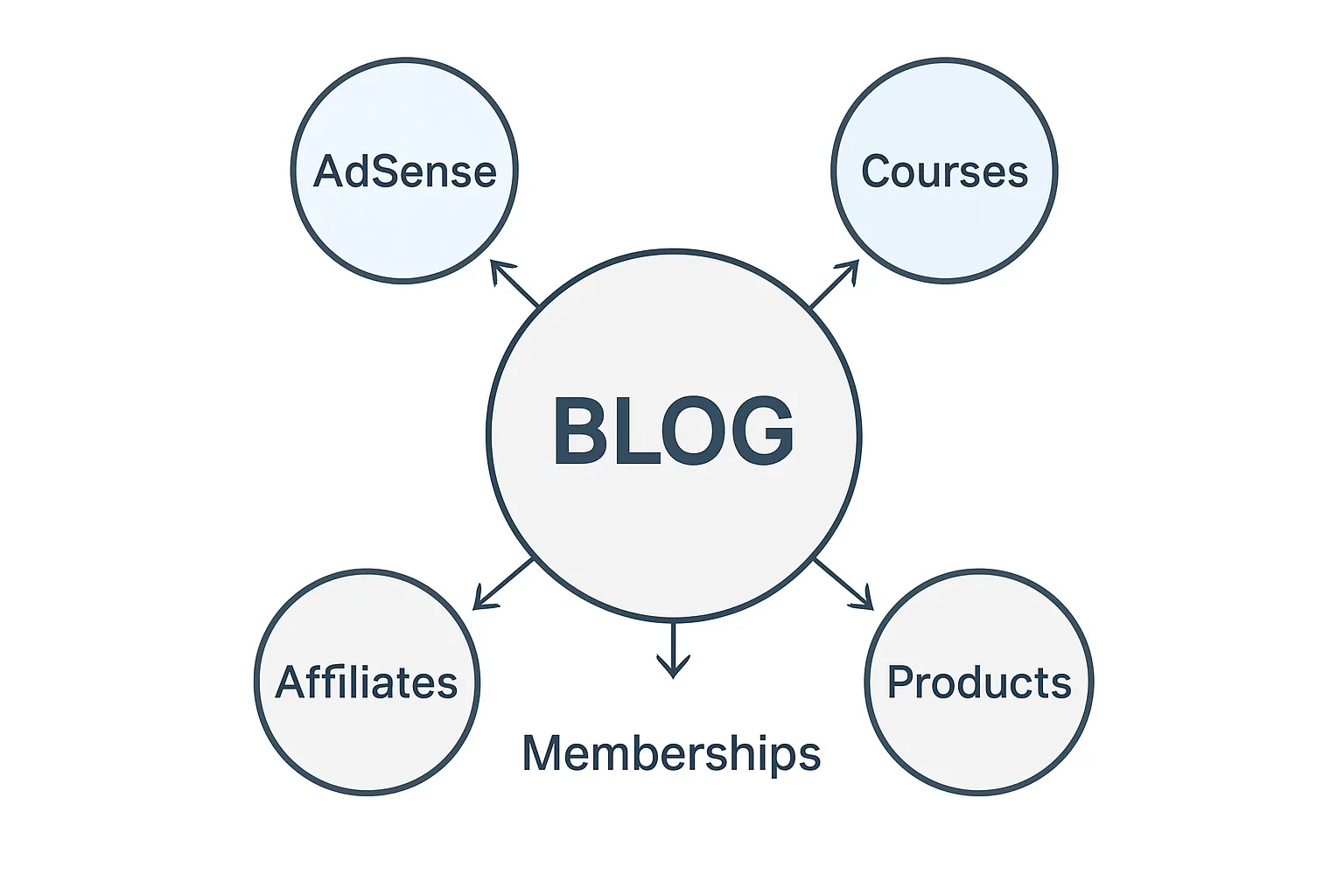
Security, Maintenance & Support
Blogger
Google-managed infra, SSL by default, and 2FA via your Google account for strong baseline protection
Limited control over backups, incident response, and custom hardening (e.g., WAF rules, server configs)
Dependency on account standing and platform policies; fewer options for disaster recovery planning beyond content export
WordPress
You own updates, backups, and security - or offload to managed WordPress hosting for automated patching and monitoring
Harden with security plugins, Web Application Firewall (WAF), brute-force protection, malware scanning, and IP allow/deny lists
Automatic backups (daily or on-demand), offsite storage, and staging environments for safe testing before deployment
Update hygiene matters: keep core, themes, and plugins current; prune unused extensions; vet vendors by reputation, update cadence, and code quality
Support landscape
Blogger: help docs + community forum; limited direct support pathways
WordPress: massive global community and forums, hosting provider support (often 24/7), and vendor support for premium themes/plugins - plus extensive third-party documentation and training resources
Pricing & Total Cost of Ownership (TCO)
Blogger costs
Free hosting, SSL, and subdomain; optional custom domain
Opportunity cost: limits on customization, integrations, and growth features
WordPress costs
Domain + hosting (shared vs managed), optional premium themes/plugins
Scaling costs: CDN, backups, security suite, performance plugins if needed
Sample TCO scenarios (annualized)
Hobby blog vs growing business blog (entry-level vs managed stack)
Tips to control spend
Start lean with high-quality free themes/plugins
Use managed hosting bundles that include SSL, backups, CDN, staging
Cost Component | Blogger (Custom Domain) | WordPress (Starter Shared Hosting) | WordPress (Managed Plan) |
|---|---|---|---|
Domain | $12–$20 | $12–$20 | $12–$20 |
Hosting | $0 (Google hosted) | $60–$120 | $300–$600 |
SSL | $0 | $0 (often included) | $0 (included) |
CDN | $0 | $0–$120 | $0–$120 (often included) |
Backups | Limited (exports) | $0–$60 | $0 (included) |
Security/WAF | Platform-level | $0–$99 | $0 (included) |
Premium Theme (optional) | $0–$50 | $0–$79 | $0–$79 |
Premium Plugins (optional) | N/A | $0–$200 | $0–$200 |
Email/Newsletter (optional) | $0–$180 | $0–$180 | $0–$180 |
Estimated Annual Total (lean setup) | $12–$20 | $75–$200 | $312–$620 |
Estimated Annual Total (growth-ready) | $50–$230 | $250–$700 | $500–$1,200 |
Final Verdict + Decision Checklist (and When to Consider BlogBowl)
Who should choose Blogger
You want a free, simple, maintenance-free personal blog and AdSense is enough
Who should choose WordPress
You need brand control, advanced SEO, integrations, monetization variety, or room to scale
Decision checklist
Ownership and portability (custom domain, exports, redirects)
Integrations and ecosystem needs (email, CRM, automation)
SEO depth and performance targets (schema, CWV, redirects)
Design and branding requirements (themes, FSE, page builders)
Monetization plans (ads, affiliates, memberships, products)
Maintenance appetite (updates, backups, security)
Budget/TCO and growth trajectory
Fast migration notes
Blogger → WordPress steps: export XML from Blogger, import into WordPress, map authors, fix media, match permalinks
Redirects & SEO: implement 301 redirects, set canonicals, submit new sitemaps in Search Console, monitor 404s and fix internal links
When BlogBowl is the better fit
Launch fast with an SEO-optimized blog and let AI handle topic research, daily content drafts, internal linking, and embedded media - plus built-in analytics and newsletter
Ideal for SaaS/startups needing consistent content velocity and growth with minimal overhead; no hosting or plugin maintenance required
